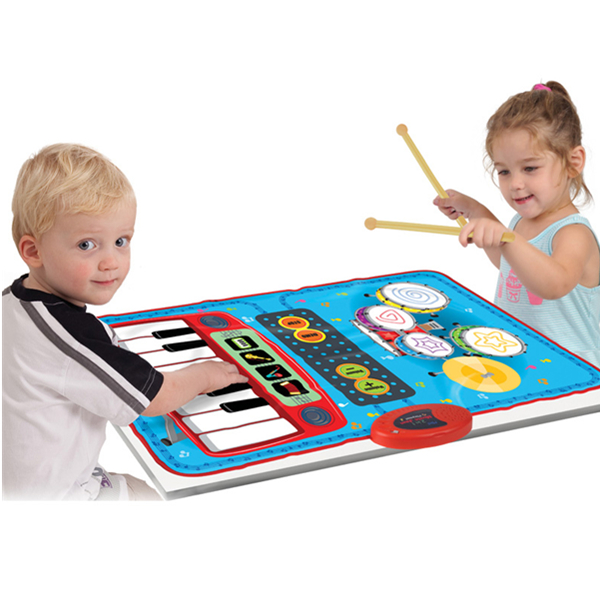How to teach a kid to share toys with others (part two)
Three kinds of training
After the kid has awareness of ownership, parents must also guide them correctly and teach him what is sharing.
Taking away and sending back training
When parents and their kid are at home, they can do some training like "borrowing toys" - Mother borrows a hat from father and then returned it to him. Father borrows a toy from the kid and gives it back to the kid within the prescribed time. After doing enough "taking away" and "send backing" demonstrations between mom and dad, try to borrow toys from the kid. Of course, in the process of borrowing things, the owner of the item has the right to say no. If the kid says no, parents need to show respect to the kid's decision. When the kid realizes that what he has borrowed will not disappear and will come back, he is willing to try to share.
Fair sharing training
Some things will not come back after sharing, like food. But let the baby know that this kind of sharing does not mean nothing. When eating fruit, mom can ask dad, "Do you want to eat apples? I can share half with you." When the kid is eating snacks, parents can also ask, "Can you give me a little bit?" Sharing food is not about giving everything to others. If the baby has only one biscuit in hand, fifty-fifty is the fairest way to share, not giving the entire one. Even many adults can't give their own things to others unconditionally, let alone kids. Therefore, sharing such items must be based on the principle that the baby is willing to share.
Taking turns training
Newly-bought toys do not belong the kid yet, maybe parents also want to fiddle with at the same time. At this time, parents can make rules with the kid to play in turn. First, decide the order and time with the kid. Then set an alarm. When the alarm clock goes off, whoever taking the toy should give it to the next person. For toys that everyone can play at the same time, it is necessary to make rules with the kid. Also, remind each other to follow the rules when playing the game. In the process of training, you should also follow the kid's willingness, understand his feeling when the kid is not willing to share, do not force him to share in accordance with the standard of a saint. It is not important for the kid to share, but to let him understand that sharing can be fair and happy.
Actual practice - sharing with peers
Parents can also let the baby practice sharing toys when he is playing with other kids. But everyone receives a different family education and your kid may encounter various challenges in the process of sharing with other kids.
And here are three suggestions for parents. First, safeguard your kid's right when necessary to help your kid defend his ownership of his belongings, or remind him that his sharing may bring him more friends and more happiness. Second, kids under the age of three have not formed a good sharing awareness, parents can make a simple reconciliation between the two kids. Third, when the kid shares his toys or gets more happiness through sharing, parents need to encourage and praise him in time so as to amplify his happiness brought by sharing, and the kid will be more willing to share.
Sharing with willingness is a kind of virtue but forcing others to share is not. Parents need to be patient and wait. The kid will eventually learn how to share.

After the kid has awareness of ownership, parents must also guide them correctly and teach him what is sharing.
Taking away and sending back training
When parents and their kid are at home, they can do some training like "borrowing toys" - Mother borrows a hat from father and then returned it to him. Father borrows a toy from the kid and gives it back to the kid within the prescribed time. After doing enough "taking away" and "send backing" demonstrations between mom and dad, try to borrow toys from the kid. Of course, in the process of borrowing things, the owner of the item has the right to say no. If the kid says no, parents need to show respect to the kid's decision. When the kid realizes that what he has borrowed will not disappear and will come back, he is willing to try to share.
Fair sharing training
Some things will not come back after sharing, like food. But let the baby know that this kind of sharing does not mean nothing. When eating fruit, mom can ask dad, "Do you want to eat apples? I can share half with you." When the kid is eating snacks, parents can also ask, "Can you give me a little bit?" Sharing food is not about giving everything to others. If the baby has only one biscuit in hand, fifty-fifty is the fairest way to share, not giving the entire one. Even many adults can't give their own things to others unconditionally, let alone kids. Therefore, sharing such items must be based on the principle that the baby is willing to share.
Taking turns training
Newly-bought toys do not belong the kid yet, maybe parents also want to fiddle with at the same time. At this time, parents can make rules with the kid to play in turn. First, decide the order and time with the kid. Then set an alarm. When the alarm clock goes off, whoever taking the toy should give it to the next person. For toys that everyone can play at the same time, it is necessary to make rules with the kid. Also, remind each other to follow the rules when playing the game. In the process of training, you should also follow the kid's willingness, understand his feeling when the kid is not willing to share, do not force him to share in accordance with the standard of a saint. It is not important for the kid to share, but to let him understand that sharing can be fair and happy.
Actual practice - sharing with peers
Parents can also let the baby practice sharing toys when he is playing with other kids. But everyone receives a different family education and your kid may encounter various challenges in the process of sharing with other kids.
And here are three suggestions for parents. First, safeguard your kid's right when necessary to help your kid defend his ownership of his belongings, or remind him that his sharing may bring him more friends and more happiness. Second, kids under the age of three have not formed a good sharing awareness, parents can make a simple reconciliation between the two kids. Third, when the kid shares his toys or gets more happiness through sharing, parents need to encourage and praise him in time so as to amplify his happiness brought by sharing, and the kid will be more willing to share.
Sharing with willingness is a kind of virtue but forcing others to share is not. Parents need to be patient and wait. The kid will eventually learn how to share.

Related News
- Perfect Electronic Playmats for Children with Different Constellations (Part Four)
- Perfect Electronic Playmats for Children with Different Constellations (Part Three)
- Perfect Electronic Playmats for Children with Different Constellations (Part Two)
- Perfect Electronic Playmats for Children with Different Constellations (Part One)
- Four Musical Toys to Foster Baby's Music and Hearing Ability
- Three steps to organize toys and spare space for kids to play
- Three principles that keep your kids away from dangerous toys
- How to teach a kid to share toys with others (part two)
- How to teach a kid to share toys with others (part one)
- How to get children to tidy up toys
